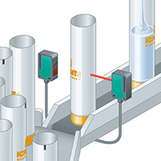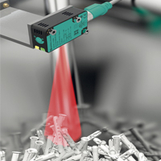The emitter and receiver on thru-beam sensors are aligned opposite one another. The advantage of this is that the light reaches the receiver directly and long detection ranges and high excess gain can therefore be achieved. These sensors are capable of reliably detecting almost any object. The angle of incidence, surface characteristics, color of the object, etc., are irrelevant and do not influence the functional reliability of the sensor.


The emitter and receiver are aligned in a housing such that the retroreflective sensors are easy to install. Simply position a reflector on the opposite side and align the sensor with it. The standard version featuring a polarization filter combines the installation benefits offered by the retroreflective system with the reliable detection, even of reflective objects, at long detection ranges. The retroreflective sensors for clear object detection are ideal for reliably detecting transparent objects.
Diffuse mode sensors are particularly easy to install, since only one device has to be fitted and no reflector is required. These sensors operate primarily at close range, feature optimum switching accuracy, and can reliably detect even very small objects. The sensors with background suppression sense only a specific area in front of the sensor. The sensor ignores any objects that are outside of this area. Sensors with background suppression are also insensitive to interfering objects in the background and are still extremely precise. Sensors with background evaluation are always used in applications with a fixed background in the measuring range with which you can align the sensor.


Fiber optic sensors and cables are the perfect solution for applications where the direct mounting of sensors is not possible due to space restrictions, temperature extremes, and so on. Small fiber optic beams are ideal for detecting tiny objects.